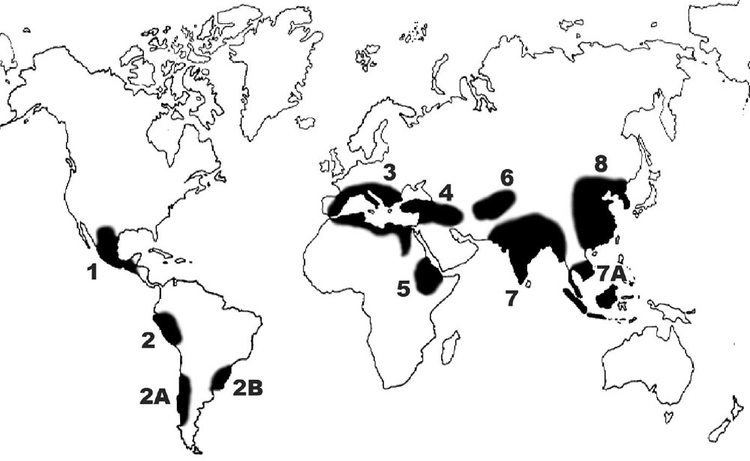 | ||
A center of origin (or centre of diversity) is a geographical area where a group of organisms, either domesticated or wild, first developed its distinctive properties. Centers of origin are also considered centers of diversity. Nikolai Vavilov initially identified 8 of these, later subdividing them into 12 in 1935.
Contents
Plants
Locating the origin of crop plants is basic to plant breeding. This allows one to locate wild relatives, related species, and new genes (especially dominant genes, which may provide resistance to diseases). Knowledge of the origins of crop plants is important in order to avoid genetic erosion, the loss of germplasm due to the loss of ecotypes and landraces, loss of habitat (such as rainforests), and increased urbanization. Germplasm preservation is accomplished through gene banks (largely seed collections but now frozen stem sections) and preservation of natural habitats (especially in centers of origin).
Vavilov centers
A Vavilov Center (of Diversity) is a region of the world first indicated by Nikolai Vavilov to be an original center for the domestication of plants.
Vavilov developed a theory on the centers of origin of cultivated plants. He stated that plants were not domesticated somewhere in the world at random but there are regions where the domestication started. The center of origin is also considered the center of diversity.
Vavilov centers are regions where a high diversity of crop wild relatives can be found, representing the natural relatives of domesticated crop plants. Later in 1935 Vavilov divided the centers into 12, giving the following list:
- Chinese center
- Indian(Hindustan) center
- Indo-Malayan center
- Central Asiatic center
- Persian center
- Mediterranean center
- Abyssinian center
- South American center
- Central American center
- Chilean center
- Brazilian center
- North American center
World centers of origin of cultivated plants
Importance
In 2016, researchers linked the origins and primary regions of diversity ("areas typically including the locations of the initial domestication of crops, encompassing the primary geographical zones of crop variation generated since that time, and containing relatively high species richness in crop wild relatives") of food and agricultural crops with their current importance around the world in modern national food supplies and agricultural production. The results indicated that foreign crops were 68.7% of national food supplies as a global mean, and their usage has greatly increased in the last fifty years.
